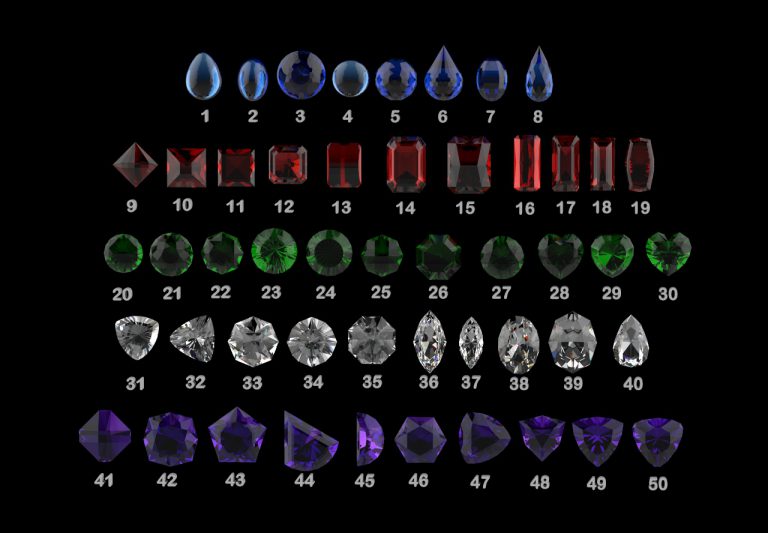Professional approach to choosing a ring
There is a distinct trend for ‘uniqueness’ when it comes to choosing jewelry nowadays. Customers are adventurous and no longer afraid to experiment with metals, stones and shapes, demanding tailor-made approach when it comes to all the parts of their jewelry. We are going to discuss some cornerstone ring settings to inspire our customers to come up with designs reflecting their own individuality.
There are multiple ways gemstones are set to the jewelry item: Bead Setting, Pave Setting, Bezel Setting, Gypsy/Flush Setting, Channel, Prong Setting, Invisible Set, etc.
The main purpose of a setting is to highlight the beauty of stones, organically fitting them in the design taking into consideration the type and size of a stone, its shape and cut. The shape and cut determine how the mineral reflects the light, in other words, how sparkly the stone will look like and what type of setting will be the most appropriate to hold it properly.
Let’s start with smaller sized stones and their settings.
Bead Setting
Being all the rage during late 1800s, the rows of small diamonds are raising popularity again thanks to 2 factors – CAD technologies, which make it much less labor- and time-consuming to mount the gems, and secondly – domination of white gold and platinum in today’s market, which is a perfect match with small diamonds.
Pave setting
This is basically a bead setting covering all the field. The ring’s surface incrusted with diamonds looks incredibly chick.
Bezel setting
The names comes the first jeweler known in history – Bezalel, the constructor of the Ark of the Covenant. Cabochons and faceted stones are wrapped into metal rims, encircling them fully or only part of them. A bezel setting holds a gemstone securely, making it a good choice for people with active lifestyles.
Gypsy/flush setting
Similar to Bezel setting, the stones are deeply covered, but now they are sitting flush with surface of the metal, providing the ring with the flair of understated elegance.
Channel
is a classic example of a mount with one row of gems surrounded with 2 walls. This style is utterly captivating, giving an item a clean contemporary look. Jewelry ABCs teaches us that inset mounts promise more protection to the gem compared to prongs (metal projections holding a stone). But it’s not always the case. A luscious example of that would be an Invisible Set. Several rows of diamonds here are held by metal only at ring’s edges, while the middle rows are secured mainly by the metal underneath and grooves cut into the stone to hold them. Although it might look gorgeous, it is not the most practical solutions in terms of fixing it once a gem falls out. Even finding a jeweler skilled enough to do the initial setting is not a trivial task. Bigger stones are masterpieces without any additional decorations.
Cuts
Princess cut
is a square cut with pointed corners. This contemporary beauty looks gorgeous in classic and geometric settings, and is second in popularity, offering the brilliance of a round brilliant diamond at a lower price.
Cushion cuts
are perfect for big stones, their softened edges give the item more sparkle and somewhat of a vintage feel. Cushion diamonds are an ideal choice for vintage-inspired settings.
Emerald cut
with its glassy table and step-cut facets is ideal for stones of high clarity, not necessarily emeralds. The long shape visually elongates the hand, making the look exquisite and aristocratic, making this cut ideal for fans of understated elegance.
Asscher
It is often called a “square emerald cut” for its square shape and cropped corners. This cut is a good choice for a stylish person appreciating tradition. Asscher and emerald diamonds are for a sleek, elegant appearance.
Oval cut
with its symmetrical design and elongated shapes is known for its ‘princessy’ look, with bit of adventurous flair.
Unique shape of a pear or a ‘teardrop’ shape makes smaller stones look bigger. This is a choice of risk-takers with excellent taste.
Marquise cut
Inspired by the smile of Marquise de Pompadour, this cut is for unconventional personalities and die-hard romantics. Marquise, oval, and pear-shaped diamonds help fingers look long and slender.
Less known cuts are your wallet’s friends due to the law of demand and supply. You can save up to 40 percent by selecting a non-round diamond such as trillions, baguettes, and half-moons.
Trillion cut
Diamonds are triangular in shape and highly faceted, which means they’re incredibly shiny.
Half moon cut
The crescent cut used to be chosen for side diamonds, together with the baguette diamond, but now they are a fresh alternative to traditions.
Are you interested in a complete collection of 50 most used stones cuts for your jewelry 3d creations?
Download them and start creating!
You can get them here!!!:
https://www.cgtrader.com/3d-models/various/various-models/50-gemstones-collection-for-jewelry


